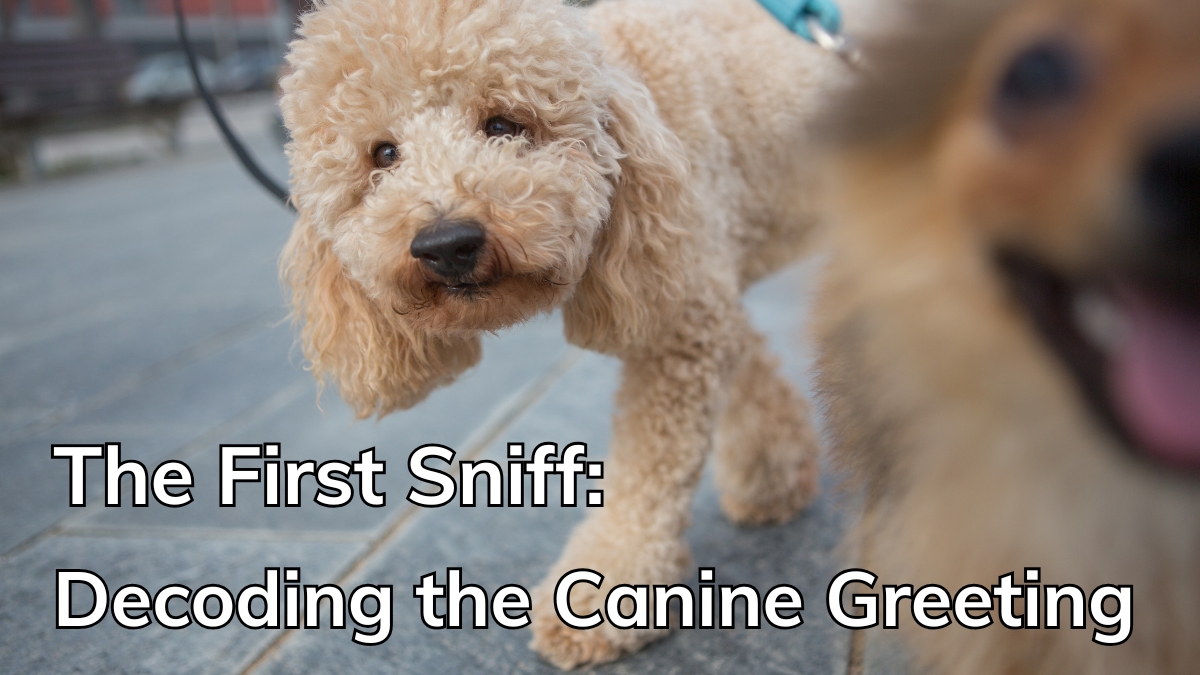The First Sniff: Decoding the Canine Greeting

Understanding greetings in the canine world
Have you ever noticed your dog sniffing someone from a distance? It’s a behaviour we often overlook, but it holds a wealth of information about how dogs perceive the world — and how they communicate.
Sniffing from Afar: A Dog's Version of Social Scanning
Dogs have an incredible sense of smell — up to 100,000 times more sensitive than ours. When your dog pauses to sniff the air while someone is approaching, they're likely gathering vital information: Is this person familiar? Are they carrying scents from another dog? Do they feel safe?
This distant sniffing is often your dog’s way of “checking someone out” before deciding whether to engage. It's subtle, yet deeply social — like humans glancing up to assess whether someone approaching looks friendly, familiar, or best avoided.
The First Sniff: Decoding the Canine Greeting
Think about where your dog sniffs first when they greet you. Is it your hand, your legs, your feet? Dogs tend to be drawn to the parts of us that hold the strongest, freshest scents — and they'll often dive straight in to ready those stories from the outside world.
Now compare that to how they greet a stranger. Often, dogs will cautiously approach and begin with a more investigative sniff — typically around the feet or legs — moving towards and away. This is their way of gathering information in a safe, non-threatening way.
These greetings might seem casual or even barely there, but to a dog, they’re meaningful. They help your dog make decisions: Should I stay close? Should I move away? Is this person part of my world now?
Cross-Species Greetings: What Counts as a "Hello"?
Let’s turn the lens onto ourselves for a moment. In many cultures, a simple nod from across the street can serve as a polite greeting — an acknowledgement of another person’s presence without words or physical contact.
Dogs do something very similar. A brief sniff from a distance, a pause while watching another dog pass, a subtle head turn — these are canine ways of saying “I see you” without rushing into a full-on interaction.
When we start to notice these quieter, gentler forms of greeting, we begin to understand just how socially rich and emotionally aware our dogs really are.
Why This Matters: Less Barking, More Understanding
Here’s where it gets really useful: when we tune in to our dog’s first sniffs, we can actually reduce a lot of the barking, shouting, and stress.
Many dogs don’t want to be petted right away — or even looked at directly. They’d rather assess someone from a distance, take a few sniffs of their shoes, and then decide whether to come closer. But when we (or others) go straight in with hands and voices, it can feel overwhelming and unsafe to our dogs. That’s when the barking starts — not because they’re being “naughty,” but because they didn’t feel heard.
By understanding and respecting a dog’s preferred greeting style, we can help them feel safer, reduce tension, and create calmer social interactions. Sometimes, giving a dog space to sniff is the kindest hello we can offer.
Next time you're out with your dog, try this:
🌿 Notice when they sniff the air — what’s caught their attention?
👃 Watch where they sniff first when greeting people — what patterns emerge?
🚫 Avoid rushing greetings — see what happens when you just wait and let your dog lead.
👋 And reflect on how you greet others from afar — are we really so different?
By tuning into your dog’s subtle social cues, you’ll start to see the world through their nose — and deepen your bond in the process.
⭐⭐⭐⭐⭐
Want to Learn More?
Stephie is a dog professional specialising in trauma-informed behavioural support for shouty-barky dogs, dogs with separation anxiety, and sensitive rescues.
Join her on facebook: www.facebook.com/groups/TheShoutyBarkyDogGroup
And when you're ready for a truly consultative approach to building trust with your sensitive dog, reach out for a chat here:
💚 www.CalmerCanines.co.uk/chat 💚
⭐⭐⭐⭐⭐
 Stephie Guy
Stephie Guy 